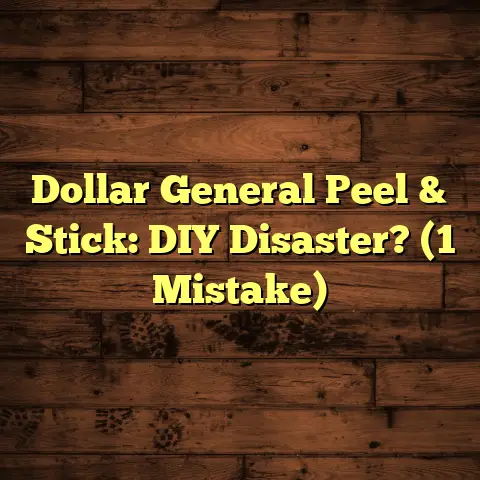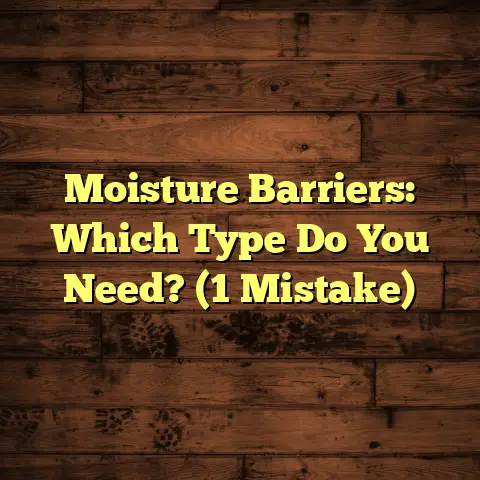Sealing Quarry Tile: Is It Possible? (2 Sealant Alert!)
(2 Sealant Alert!)
Flooring has come a long way, hasn’t it? From simple dirt floors to today’s engineered marvels, we’ve seen it all. One material that’s made a serious comeback is quarry tile.
It’s not just a trend; it’s a testament to timeless design. Think about it – a material used for centuries, known for its rugged charm and lasting power. That’s quarry tile for you.
Today, it’s popping up everywhere, from cozy kitchens to trendy restaurants, and even sprawling commercial spaces. Why? Well, it’s versatile, eco-friendly, and frankly, it just looks good.
But here’s the big question I often get asked: Do you need to seal quarry tile? And if so, what happens if you do seal it, or what happens if you don’t? Let’s dive in!
Section 1: Understanding Quarry Tile
So, what is quarry tile, exactly? It’s not actually from a quarry like you might think. It’s made from a mix of clay, shale, and other earthy materials.
These are ground together, shaped, and then fired at super-high temperatures. This process gives quarry tile its signature durability and density.
What sets it apart? Unlike ceramic or porcelain, quarry tile is naturally slip-resistant. Plus, it’s through-bodied, meaning the color runs all the way through. So, scratches are less noticeable.
You’ll find quarry tile in a range of earthy tones – reds, browns, grays. The textures can vary too, from smooth to slightly rough. This variety makes it easy to find something that fits your style.
Historically, quarry tile has been a workhorse. Think kitchens, bathrooms, and industrial spaces. Its resistance to water and wear made it ideal.
Benefits? Oh, there are plenty! It’s incredibly durable, stands up to heavy foot traffic, and is easy to clean. Plus, it’s a green choice, made from natural materials.
Section 2: The Purpose of Sealing
Okay, let’s talk sealing. Sealing a floor means applying a protective coating that soaks into the surface. This barrier helps prevent stains, reduces water absorption, and minimizes wear and tear.
There are tons of sealants out there – acrylics, epoxies, urethanes, and penetrating sealers. Each has its own strengths and weaknesses. Some offer better stain resistance, while others are more durable against abrasion.
Why seal at all? Well, porous materials like grout and some natural stones can soak up spills like a sponge. Sealing helps prevent this, keeping your floors looking newer, longer.
What if you don’t seal? You risk staining, mold growth, and even structural damage over time. Think of a neglected kitchen floor with grease stains that just won’t come out. Not fun, right?
I consulted with my buddy Mark, a flooring specialist with 20+ years of experience. He says, “Sealing is like insurance. You might not need it all the time, but when you do, you’ll be glad you have it.”
Section 3: Is Sealing Necessary for
Quarry Tile?
Now, here’s where it gets interesting. Sealing quarry tile isn’t always a no-brainer. Some argue that its natural density makes it resistant enough on its own. Others swear by sealing to maximize protection.
Let’s look at the pros and cons. On one hand, sealing can enhance the tile’s color and provide an extra layer of defense against spills and grime.
On the other hand, sealing can change the tile’s natural look and feel. Plus, some sealants can create a slippery surface, which is a no-no.
I remember a homeowner in Chicago who decided not to seal her quarry tile kitchen floor. She loved the natural, rustic look. But after a year, she regretted it. Red wine stains were impossible to remove.
Then there’s the restaurant owner in Miami who sealed his quarry tile patio. He chose a matte finish sealant to maintain the natural look while adding protection against grease and spills.
A common misconception is that all quarry tile is created equal. The truth is, porosity can vary. Some tiles are denser than others, so sealing needs can differ.
Sealing can definitely enhance the tile’s natural color and texture. It can also make cleaning easier. But, it can also create a film that some find unnatural or that requires maintenance.
Section 4: Sealant Alert!
Alright, let’s get down to specifics. I’m going to highlight two sealants that are popular for quarry tile:
-
Aqua Mix Sealer’s Choice Gold: This is a penetrating sealer. It’s designed to soak into the tile without changing its appearance. It’s water-based, low-VOC, and great for stain protection.
-
Miracle Sealants 511 Impregnator: This is another penetrating sealer, but it’s solvent-based. It offers excellent water and oil resistance. It’s a bit stronger than Aqua Mix, but it has a higher VOC content.
Aqua Mix is known for its ease of use and eco- friendliness. Users love that it doesn’t change the tile’s look. However, it might require more frequent reapplication in high-traffic areas.
Miracle Sealants 511 is a heavy-duty option. It’s ideal for areas prone to spills and stains. But, the solvent base means you need proper ventilation during application.
In terms of effectiveness, both are top-notch. Aqua Mix is great for everyday protection, while 511 is better for tougher environments.
One user on a flooring forum said, “I used Aqua Mix on my kitchen floor, and it’s been great. No stains, and it looks just like it did before I sealed it.”
Another user commented, “511 is the real deal. I used it on my restaurant’s patio, and it’s saved us from countless grease spills.”
Section 5: Application Process for Sealing
Quarry Tile
Okay, ready to seal? Here’s a step-by-step guide:
-
Clean the Surface: Use a good quality tile cleaner to remove all dirt, grease, and old sealant. Rinse thoroughly and let the floor dry completely.
-
Test the Sealant: Apply a small amount of sealant in an inconspicuous area to see how it affects the tile’s appearance.
-
Apply the Sealant: Use a clean brush, roller, or sprayer to apply a thin, even coat of sealant. Follow the manufacturer’s instructions for coverage.
-
Wait: Allow the sealant to penetrate the tile for the recommended time. This is usually 5-10 minutes.
-
Remove Excess: Use a clean cloth to wipe away any excess sealant from the surface.
-
Cure: Allow the sealant to cure completely before walking on the floor. This can take 24-72 hours.
Common mistakes? Applying too much sealant, not cleaning the surface properly, and not allowing enough drying time.
Tools you’ll need: Tile cleaner, sealant, brush or roller, clean cloths, and safety glasses.
Safety first! Always wear gloves and eye protection when working with sealants. And make sure you have proper ventilation, especially with solvent- based products.
Conclusion
So, is sealing quarry tile necessary? It really depends. If you want to maximize protection and enhance the tile’s appearance, sealing is a good idea. But, if you prefer the natural look and are diligent about cleaning, you might be able to skip it.
Aqua Mix and Miracle Sealants 511 are both great options, depending on your needs. Aqua Mix is eco-friendly and easy to use, while 511 offers heavy-duty protection.
Ultimately, the decision is yours. Think about your lifestyle, your budget, and your aesthetic preferences. And remember, a little research can go a long way in ensuring your quarry tile floors look great for years to come.
Whether you seal or not, quarry tile is a fantastic flooring choice. Its durability and timeless beauty make it a winner in my book.





